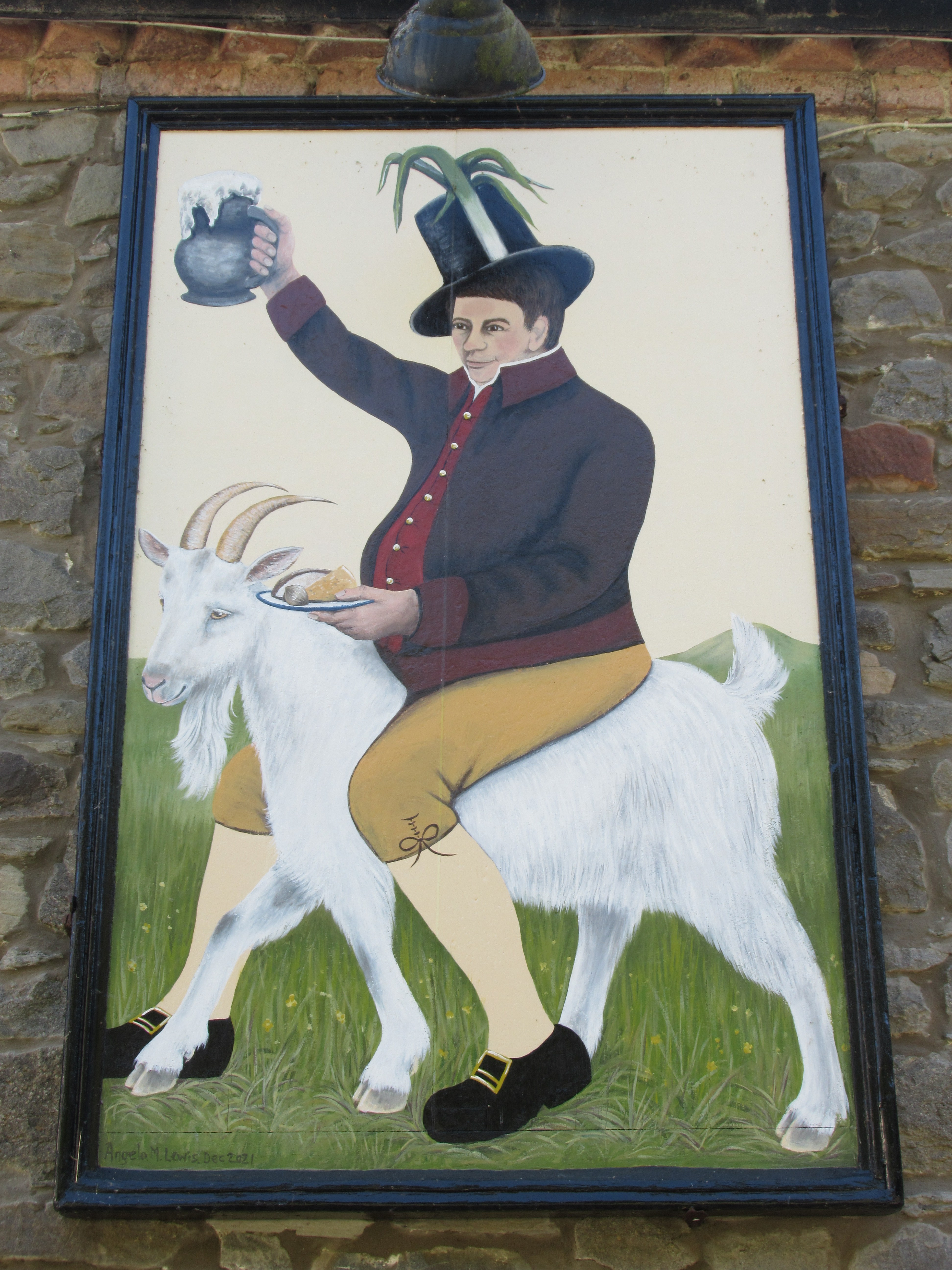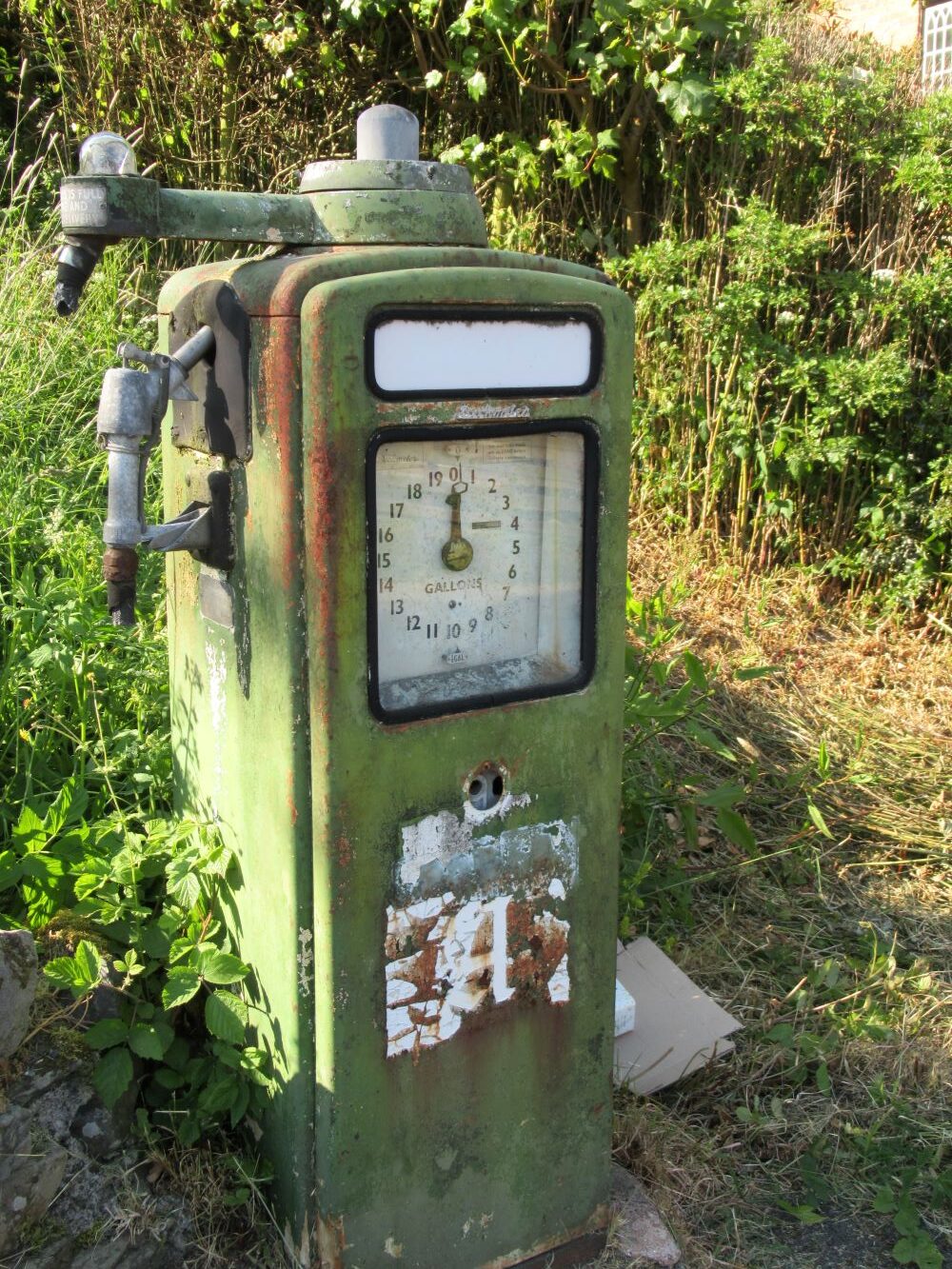
From Abbey Cwmhir we’ve three days of long walking. Today, on paper, is the longest, at over fifteen miles. In addition, the temperature is forecast to be higher; already the sun is shining and we’re down to T-shirts almost from the start. Our luggage is ready to be transported to our next stop. Yesterday we seem to have gained someone else’s battered straw hat, and we tell our host to give it shelter.
Supplied with a packed lunch – again, we won’t see a shop all day – we walk up from the Happy Union pub’s well-preserved antique petrol pump, on a straight way (was it once an old quarry track?) across a low hill called Sugar Loaf and another called Y Gôg. On a lane we pass a couple of farms, and stop to notice strange ‘dirty fleeces’ scattered across hedges – apparently the work of busy caterpillars. Crossing the Clywedog Brook, we climb on to Esgair Hill, through open sheep county with big views. Below us a farmer takes feed to a huge brown bull. We’re back in skylark territory, though they’re not a numerous as on moorland in earlier days.

Field after field goes by, each with its big gate. Gates are one of Glyndŵr’s Way’s chief features. They’ve already become our abiding obsession. We soon noticed that small gates for pedestrians – opening, kissing or any other variety – are much rarer than on most long-distance walks, and stiles are even less frequent. Instead, we’re usually faced with large metal farm gates. Just occasionally, they prove easy to open. A simple pull on the bolt, the gate yields and opens fully. When we’re all through, it swings back uncomplainingly and returns to its original position, without effort and with a satisfying clack.

But experience soon taught us to expect problems. The commonest is the ‘dropped gate’. This is when the hinges have given up the unequal task of keeping the heavy gate aligned, and withdrawing the bolt has no effect. Effectively, the gate is jammed shut. At this point you need to lift the whole gate at the catch end and simultaneously try to open it. Normally this works, but sometimes two hands (that is, two people) are needed to lift and shift the gate. Occasionally, nothing works, and there’s no choice but to admit defeat and climb over the gate. This, of course, puts even more pressure on the ‘dropped gate’ and jams it even further shut.

In the worst cases the gate has lost all connection with the post mechanism that’s supposed to hold it in place. Now the only way the farmer has to keep it shut is to drape baler twine over the top of the post. Just over the border in Montgomeryshire, we met a farmer who claimed that all Radnorshire gates were fastened with twine: an exaggeration, but not much of one.
Getting through gates isn’t made any easier by the different technologies in use. The commonest is the simple bolt, often with a spring attached. On one occasion I pulled the bolt and the whole mechanism came off in my hand, leaving me looking like a gunslinger.

Another common one is the ’45° handle’. This is where you’re supposed to lift vertically a long bar extending from the top of the gate, and then yank it sideways in the direction of the hinges to release the gate. It seldom works, and once the top of the bar came off in my hands. There are other variations, of course. Two of the rarer types are the ‘metagate’, where a conventional farm gate has within itself a smaller pedestrian gate, and the ‘gravity gate’, familiar from Offa’s Dyke, where heavy weights suspended on a wire hold the gate shut.

I could write a whole treatise on farm gates, but the main conclusion would always be the same: they give the walker nothing but pain and anguish.

At the small village of Bwlch-y-Sarnau we talk to a local who says he’s lucky to see more than one or two Glyndŵr’s Way walkers in a week (as it happens, we do meet two GW walkers today, moving in the opposite direction to us). In the centre is a handsome Baptist chapel, in Arts and Crafts style. Next door, in the community centre, you can open the porch and make yourself some tea or coffee (and mend your bicycle). It’s advertised as the Glyndŵr’s Way Café, and we stop to take advantage. As it happens, two trail riders pass through on bikes. Less happily, motorbikes also pass through here. We spot notices for ‘Enduro 2023’ and consider ourselves lucky to miss the date.
Dropping down from Bwlch-y-Sarnau through flowery meadows, we pass through a pleasant wood, and then skirt the edge of another, with wide views to our left. A lone wind turbine, with what looks like a guillotine, appear on a hill opposite. We stop for lunch and sit on some stones. We can see for miles to the west, but there are no signs of habitation anywhere, except for a few farms. This is truly empty country.

Further on, the edges of the big Llandinam windfarm come into view, and into our hearing, because these earlier turbines models seem to make more noise than later ones. At Trinnant we cross the border into Montgomeryshire. The landscape changes subtly. Instead of a succession of small hills, we’re surrounded by larger hills and broader valleys, and the grass is less green and more parched. At Pant-y-dŵr we drop steeply and then climb again to a track, at a 45° angle to our previous direction (This constant changing of orientation happens all the time on Glyndŵr’s Way, and means that you seldom know where you are, and can find yourself almost circling a single hill.)

The rest of the afternoon is a mixture of paths, tracks, woods and lanes, and the occasional farm, sometimes with aggressive dogs, fortunately well-caged, and broken-down farm buildings. There’s plenty of time for our usual conversation; today’s subjects include visits to the Royal Albert Hall, walking and books as social prescribing by doctors, and the unpleasant tendency of national anthems to include the themes of blood and soil. It’s been a hot afternoon, and we’re running out of water, but there’s no one to ask. On the approach to Llanidloes we hear a lone curlew away to our left. The way in to the town is a shy one – over the by-pass by the old railway station and alongside allotments.

A. joins us in Llanidloes for the final two days, and we try to find somewhere to eat. But it’s Friday night, and every place we try says they’re full, so in the end we plump for a Bangladeshi restaurant, which suits us all well. The pub we’re staying in is a noisy one, and sleep is impossible till after closing time. There’s no time to explore the town, one of the handsomest in mid-Wales, and we miss the church, which contains some of the arches once in the nave of the abbey church at Abbey Cwmhir.


Leave a Reply